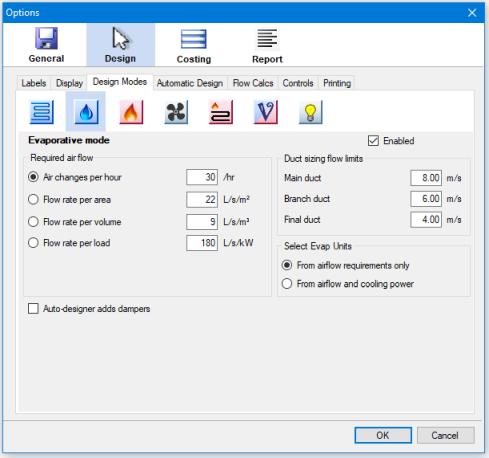Plandroid - Graphical Air Conditioning Design and Quoting Software

Evaporative Versus Refrigerative Cooling
An evaporative cooling system works by cooling air by the evaporation of water. The energy required to change the state of water from a liquid to a vapour (the enthalpy of vaporization) is extracted from the air in the form of heat as the water evaporates, thereby cooling the air. Under the right conditions, this process uses much less energy than an equivalent refrigerative system and allows more fresh air into a building. However, the maintenance requirements of an evaporative system can be significant.
The performance of an evaporative cooling system depends greatly depending on the ambient air humidity. If the ambient humidity is less than 30%, the performance is generally very good, while if it is between 30-50%, the performance can be expected to be reasonable. If the humidity is over 50%, then it is not advisable to use evaporative systems, and a refrigerative system should be used instead.
It is also important to realise that an evaporative system continually supplies fresh air from outside, while a similar refrigerative system will recycle most of the same air through the building. Because of this, an evaporative system does not have a return air path.
Designing an Evaporative Cooling System
You can select the evaporative design mode ( ) with the
Design -> Loads -> Design mode drop-down button.
) with the
Design -> Loads -> Design mode drop-down button.
You should ensure that you have loaded suitable catalogs that include evaporative units, and droppers or chutes (that are effectively starter sets for evaporative units) when you do a design in the evaporative design mode. Note that when selecting evaporative units from the parts catalog, the units' power rating shown may be only the fan motor power, and not the effective cooling power as it is for refrigerative systems.
Evaporative units are commonly sized solely based on the volumes of air that must be supplied, although they may be sized on the floor area to be serviced. Both of these figures can be shown by Plandroid - in the Options tab you can set the zone properties that you want to see displayed in your design, including the zone area and airflow requirements.
An evaporative system requires much higher air flow rates than an equivalent refrigerative system to be effective. An evaporative system will typically require a minimum of 28 to 35 air changes per hour, compared to a minimum of 8 to 10 air changes per hour for a refrigerated system. You can adjust the air changes settings used for each mode under the Options -> Design -> Design Modes:
 |
An evaporative unit is often selected based only on the total air flow requirements of the design. In the evaporative design mode settings you can select if the automatic designer selects evaporative units based on the airflow requirements only, or if both the airflow and cooling power requirements are used.
Note that when designing an evaporative system, the outlets are normally placed towards the centre of the building, so that the air flow is across a room towards an open window. This is in contrast to a reverse cycle system, where the outlets are normally placed on the outside edge of the building, and the flow is back towards the centre where the return air intake is typically located.
Go back to Design Modes overview.